BUICK ROADMASTER 1993 Owners Manual
Manufacturer: BUICK, Model Year: 1993, Model line: ROADMASTER, Model: BUICK ROADMASTER 1993Pages: 340, PDF Size: 18.34 MB
Page 161 of 340
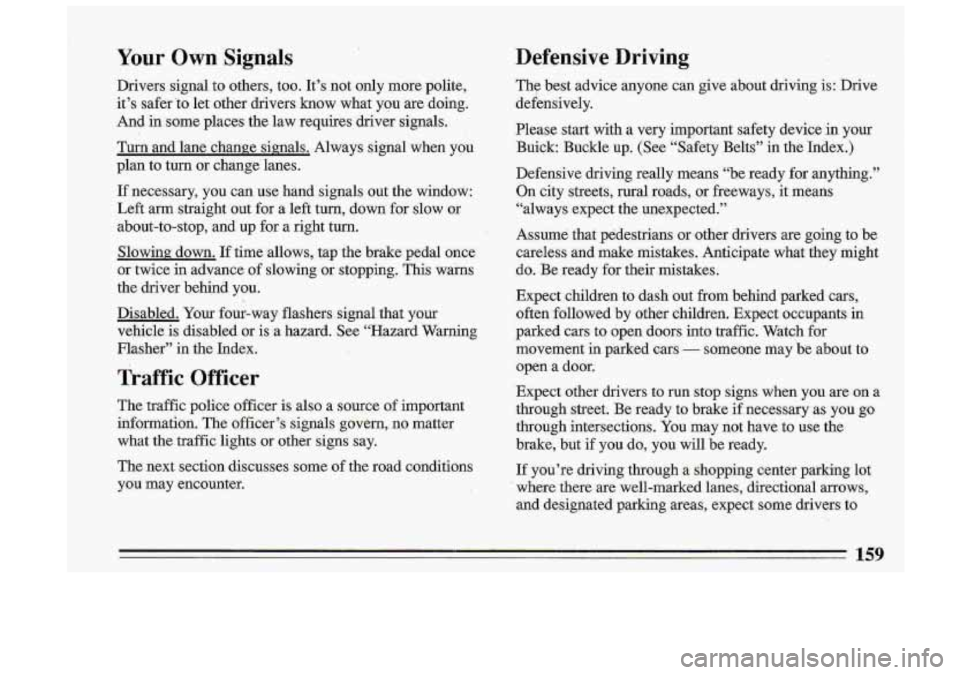
Your Own Signals Defensive Driving
Drivers signal
to others, too. It’s not only more polite,
it’s safer ‘to let other drivers know what you are doing.
And in some places the law requires driver signals.
Turn and lane change signals. Always signal when you
plan to turn or change lanes.
If necessary, you can
use hand signals out the window:
Left arm straight out for
a left turn, down- for slow or
about-to-stop, and up for a right turn.
Slowing. down. If time allows, tap the brake pedal once
or twice
in advance of slowing or stopping. This warns
the driver behind you.
Disabled. Your -four-way flashers signal that your
vehicle is disabled or is a hazard. See “Hazard Warning
Flasher” in the Index.
Traffic Officer
The traffic police officer is also a source of important
information.
The officer’s signals govern, no matter
what the traffic lights or other signs say.
The next section discusses some of the road conditions
you
may encounter. The
best advice anyone can give about driving is: Drive
i
defensively. !
Please start with a very important safety device in your
Buick: Buckle up. (See “Safety Belts” in the Index.) i
Defensive driving really means “be ready for anything.”
On city streets, rural roads, or freeways, it means
“always expect the unexpected.”
Assume that pedestrians or other drivers are going to be
careless and make mistakes. Anticipate what they might
do. Be ready for their mistakes.
Expect children to dash out from behind parked cas,
often-followed by other children. Expect occupants
in
parked cars to open doors into traffic., Watch for
movement
in parked cars - someone may be about to
open a door.
Expect other drivers to run stop signs when. you are on a
through street. Be ready to brake if necessary
as you go
through intersections. You may not have
to use the
brake, but if you do, you will be ready.
If you’re driving through a shopping center parking lot
where there are well-marked lanes, directional arrows,
and designated parking areas, expect.some drivers to
159
__
Page 162 of 340
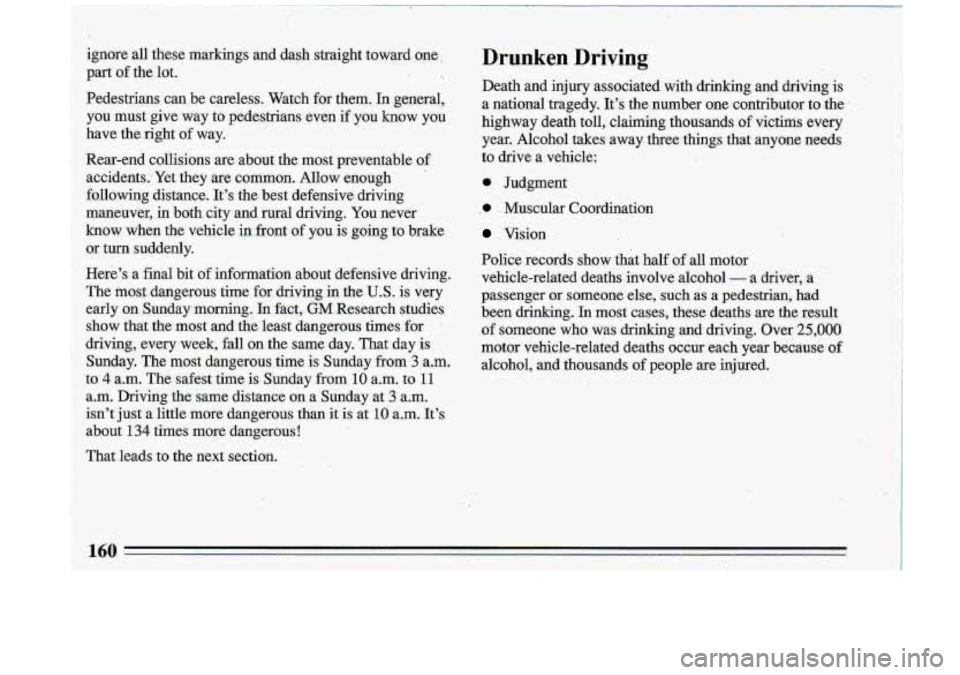
D,runken Driving
Death and injury associated with drinking and,driving is
a national tragedy. It’s the number one contributor to the
highway death toll, claiming thousands of victims every
year. Alcohol takes away. three ,things that anyone needs
to drive a vehicle:
@ Judgment
.e . Muscular Coordination
Vision
Police records show that half of all motor
vehicle-related deaths involve alcohol
- a driver, a
passenger
or someone else, such as a pedestrian, had
been drinking.
In most cases, these deaths are the result
of someone who was drinking and driving. Over 25,000
motor vehicle-related deaths occur each year becaus-e of
alcohol, and thousands of people are injured.
Page 163 of 340
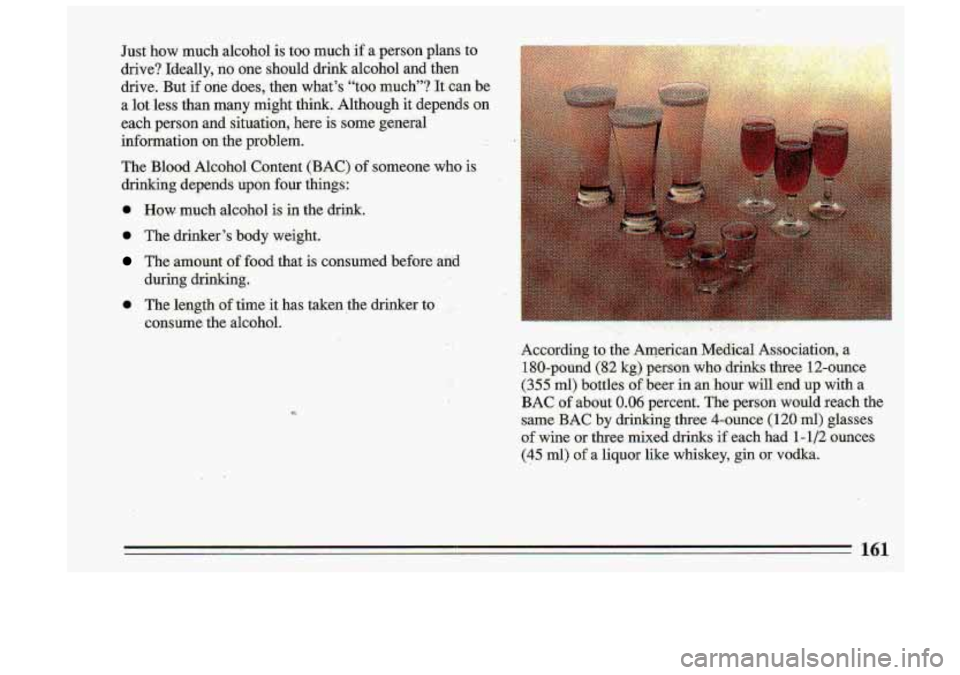
Just how much alcohol is too much if a person plans to
drive? Ideally,
no one should drink alcohol and then
drive. But if one does, then what’s “too much”? It; can be
a lot less than many might think. Although it depends on
each person and situation, here is some general
information
on the problem.
The Blood Alcohol Content
(BAC) of someone who is
drinking depends upon four things:
._
0
0
0
How much alcohol is in the drink.
..
The drinker’s body weight.
The amount
of food that is consumed before and
during drinking.
The length of time it has taken,the drinker to
consume the alcohol.
Page 164 of 340
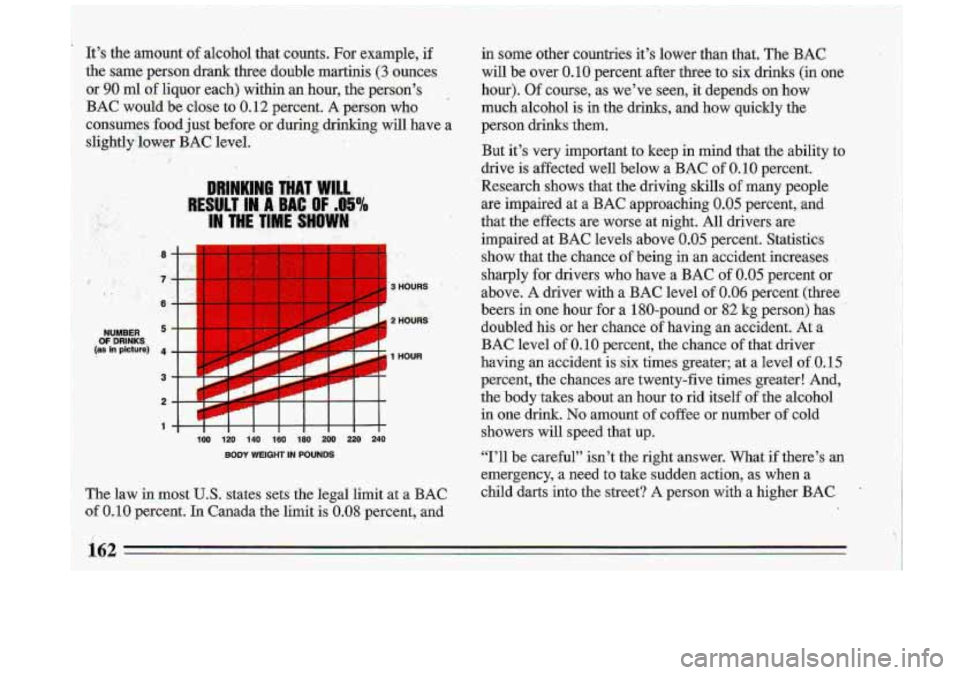
It’s the arnount.of alcahd that counts. For example, if
the same person drank three double martinis,
(3 ounces
or
90 ml of liquor each) within an hour, the persqn’s,
BAC would be close to 0.12 percent. A person who
consumes fwd
just before or during drinking will. have a
slightlyi’lower
BA@ -, level’.
..
..
DRINKING THAT WILL
, .,11 RESULT IN, A BAC -OF .@5’/0
.. IN THE JiME. SHOWN. .. .. ., C‘ , . ’/ ,.
p; ,~ I, ..I.’ ., . x-j:.
,? . 3 HOURS ’, ’ , 1, : (.
(as in picture) 4 OF DRI-NKS
T 2 7111
2 HOURS
1 HOUR
in some other countries it’s lower than that. The BAC
will be over 0.16 percent after three to six drinks (in one
hour).
Of course, as we’ve seen, it depends on how
much alcohol is in the drinks, and how quickly the
person drinks them.
But it’s very important to keep in mind that the ability to
drive is affected well below a
BAC of 0.10 percent..
Research
shows that the driving skills of many people
are impaired at
a BAC approaching 0.05 percent, and
that the effects are worse at night. All drivers are
impaired at
BAC levels above 0.05 percent. Statistics
show that the.chance
of being in an accident increases
sharply for drivers who have a
BAC of 0.05 percent or
above. A driver with a BAC level of 0.06 percent (three
beers
in one hour for a 180-pound or 82 kg person) has
doubled his or her chance
of having an accident. At a
BAC level of 0.10 percent, the chance of that driver
having an accident
is six times greater; at a level of.O.15
percent, the chances are twenty-five times greater! And,
the body takes about an hour
to rid itself of the alcohol
in one drink.
No amount of coffee or number of cold
showers will speed that up.
“I’ll be careful’’
isn’t the right,answer. What if there’s an
emergency, a need.
to take sudden action, as when a
child darts into the street? A person with a higher BAC
1 1
1:O IiO 1:O 1:O 16B 2:O 2:O 240 I
BODY WEIGHT’IN POUNDS
Page 165 of 340
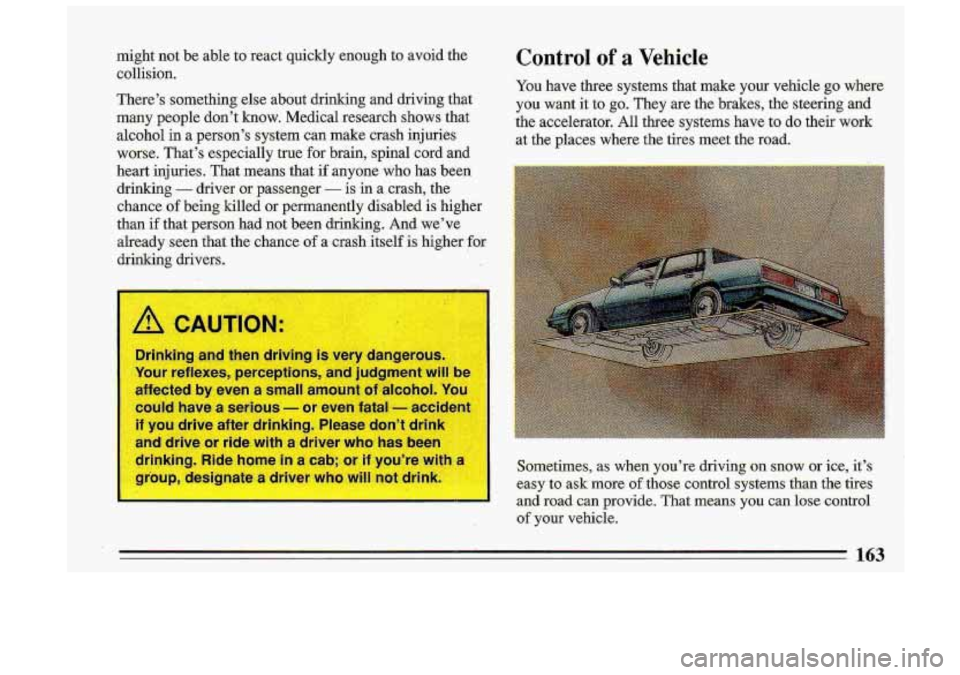
might not be able to react quickly enough to avoid the
collision.
There’s something else about drinking and driving that
many people don’t know. Medical research shows that
alcohol in a person’s system can make crash injuries worse. That’s especially true for brain, spinal cord and
heart injuries. That means that
if anyone who has been
drinking
- driver or passenger - is in a crash, the
chance of being killed or permanently disabled is higher
than
if that person had not been drinking. And we’ve
already-seen that the chance
of a crash itself is higher for
drinking drivers.
1- -
/q CAUTION:
Drinking and then driving is very dangerous.
Your reflexes, perceptions, and judgment
will be
affected by even a small amount
04 alcohol. You
could have a serious - or even fatall - accident
if you drive after drinking. Please don’t drink
and drive or ride with a driver who has been
drinking. Ride home
in a cab; or if you’re with a
group, designate a driver who will not drink.
Control of a Vehicle
You have three systems that make your vehicle go where
you want it to
go. They are the brakes, the steering and
the accelerator. All three systems have to
do their work
at the places where the tires meet the road.
Sometimes, as
when you’re driving on snow or ice, it’s
easy to ask more of those control systems than the tires
and road
can provide. That means you can lose control
of your vehicle.
163
Page 166 of 340
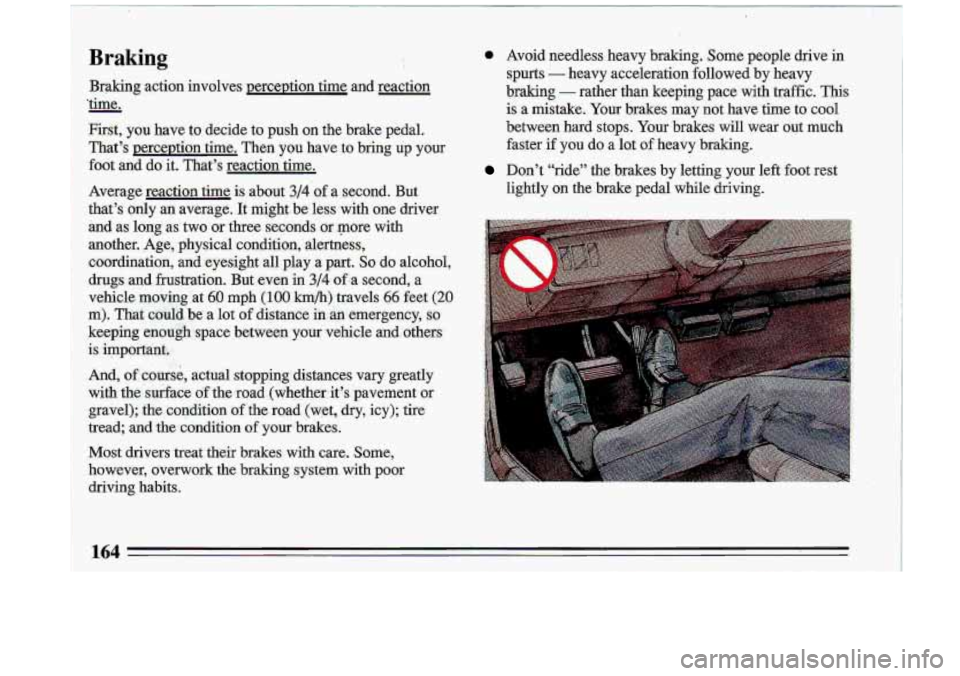
Braking
Braking action- involves perceDtion time and reaction
’time.
First, you have to decide to push on the brake pedal.
That’s perception time. Then -you have to bring
up your
foot and do it. That’s reaction-time.
-
Average reaction time is about 314 ‘of a second. But
that’s only -an average. It might be less with one driver
and as
long as two or.three seconds or .more with
another.
drugs and frustration. .But even in
3/4 0f.a second, a
vehicle moving at
60 mph (1 00 h/h) travels 66 feet: (20
m). That could. be a lot of distance in an-emergency, so
keeping enough- space between your vehicle and-others
is important.
And, of course, actual stopping distances vary greatly
with the saiface- of the raad.(whether it’s pavement or
gavel); the condition of the road (wFt, dry, icy); tire
tread; and
the condition of your brakes.
Most -drivers treat their brakes with care. Some,
however; overwork the braking system with poor
driving habits.
* Avoid needless heavy braking. Some people drive in spurts
- heavy acceleration followed by heavy
braking
- rather than keeping pace with traffic. This
is a mistake. Your brakes may not have time to cool
between hard stops. Your brakes will wear out much faster if you do a lat of heavy braking.
Don’t “ride” the brakes by letting your left foot rest
lightly on the brake pedal while driving.
Page 167 of 340
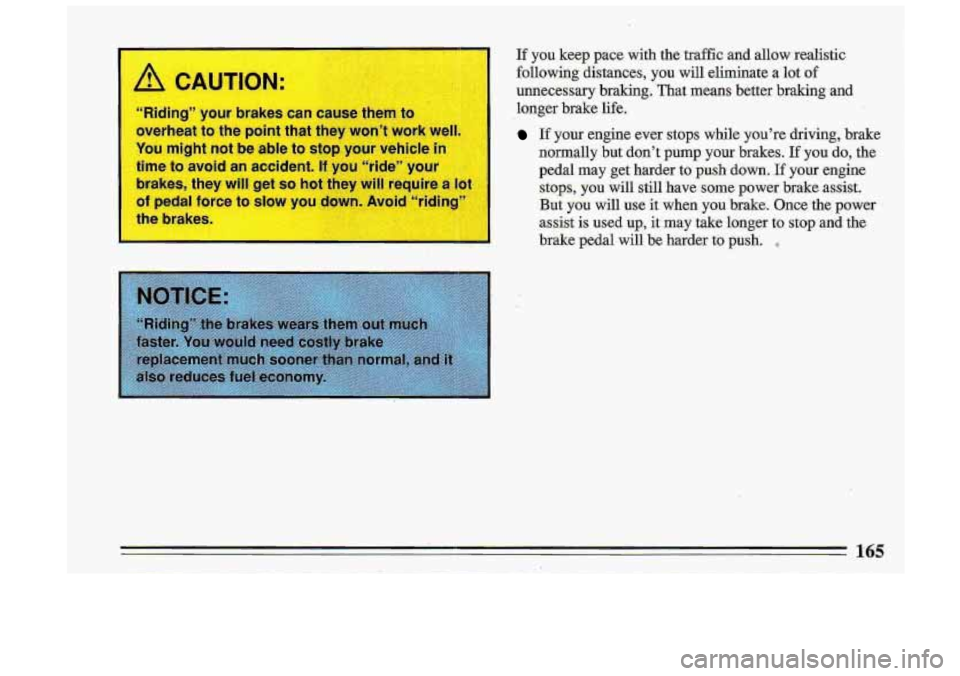
Riding” your brake
overheat to the point that they won’t work well,
You might not be able to stop your vehicle
it
time to avoid an accident. If you “ride” your
brakes, they will get
so hot they will require a 1st
of pedal force to slow you down. Avoid “ridil
the brakes.
If you keep pace with the traffic and al1,ow realistic
followirig distance.s, you will eliminate a lot
of
unnecessary braking. ‘That means better braking and
longer brake
life.
If your engine ever stops while you’re driving, brake
normally .but don’t
pump your brakes. If you do, the
pedal may get harder to push down.
If your engine
stops, you will still have some power brake. assist.
But you will use it when you brake. Once.the power
assist
is used up, it-may take longer to stop and the
brake pedal
will be harder to push.
165
Page 168 of 340
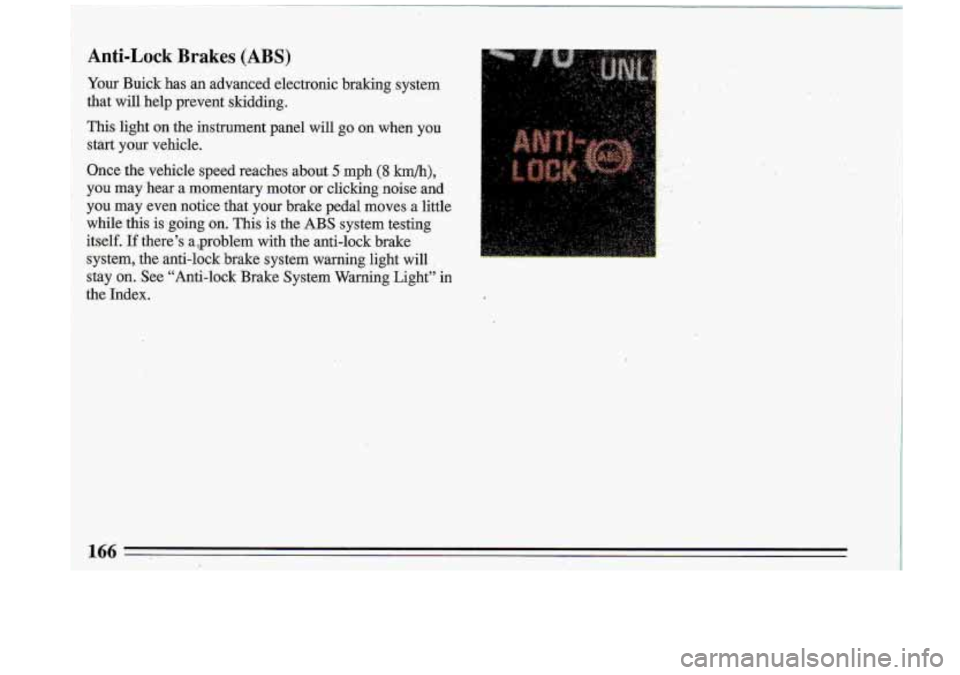
Page 169 of 340
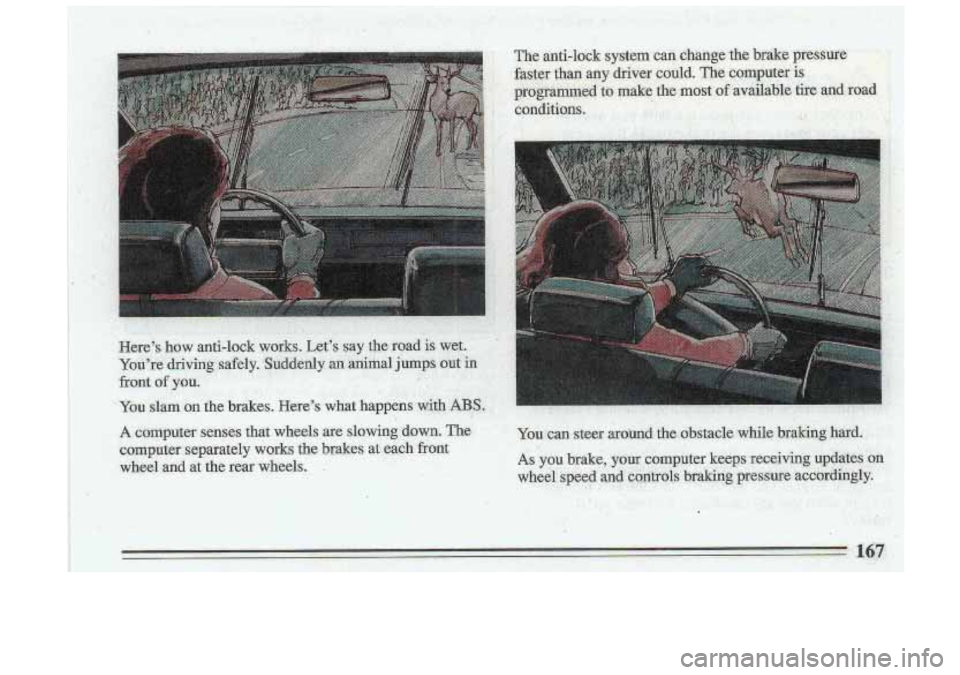
Page 170 of 340
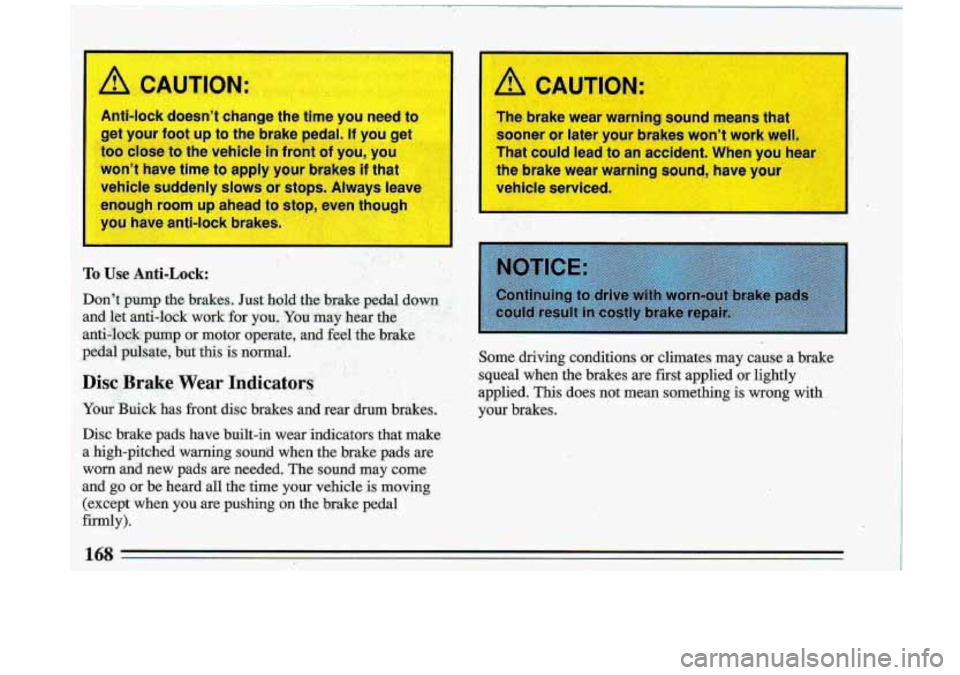
I
1 /! CAUTION: A CAUTION:
The brake wear warn g s
sooner or later your brakes won’t work well
That could lead
to an accident. When you hear
the brake wear warning
-- -3 your
vehicle serviced. -. --I - ,~
I
Some driving conditions or climates may cause a brake
squeal when the brakes are first applied or lightly
applied. This
does not mean something is wrong with
your brakes.